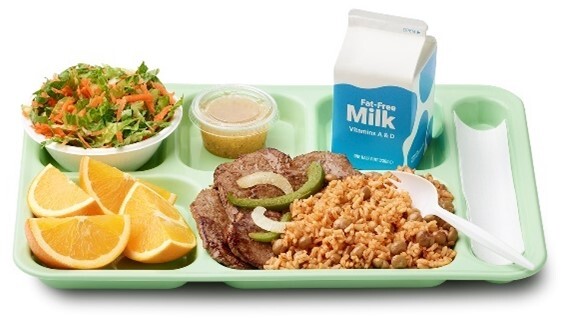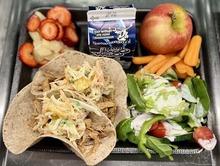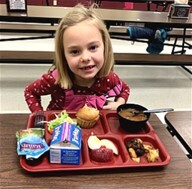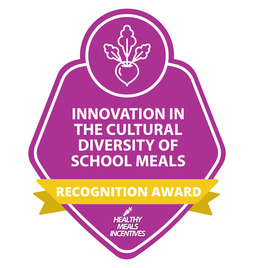|
In this edition of Team Nutrition's School Meals Grab n' Go newsletter, we feature tips to plan and prepare menus that are diverse and appealing to students! Positive food experiences and nutrition education activities can help students develop a sense of identity and acceptance, as well as expose students to a variety of foods and flavors. The following are tips to help your program embrace cultural cuisines and qualify for a Healthy Meals Incentives (HMI) Recognition Award!
Reflect the Different Cultures of Your Community

- Involve school nutrition staff when identifying new menu items, as they generally represent the diversity of the school community. In addition, they can provide input on the feasibility of preparation, which can give them a sense of pride in the new menu items.
- Connect with community partners to learn about culinary techniques of diverse dishes. Muskegon Career Tech Center (Michigan) partnered with local chefs to present on the history and preparation of soul food and provide samples of smokey rib tips, collard greens, yams, and catfish - a student favorite!
- Engage students throughout the recipe development and testing process to ensure acceptability and assist with promotion.
- Gain inspiration from school districts across the county on the many ways to offer school meals with Team Nutrition’s School Meals Trays, Many Ways resource.
Photo: Meal from Puerto Rico that includes Puerto Rican brown rice and pigeon peas served with beefsteak - Christian Military Academy
|
Serve Diverse Foods and Flavors

- Use traditional preparation techniques, ingredients, spices, and product sourcing as much as possible.
- Explore state developed recipes from Team Nutrition Training Grants that utilize local agricultural products and reflect local food preparation and taste preferences.
For more recipes from this project, visit the Institute of Child Nutrition’s Child Nutrition Recipe Box.
Photo: Peach Pork Tacos – Georgia Department of Education
|
Integrate Traditional Indigenous Foods

- Incorporate traditional Indigenous foods like bison, mesquite flour, wild rice, and ancient varieties of squash and corn into school meals.
- Provide educational activities that teach students about nutrition and traditions. Nebraska Department of Education developed Indigenous Harvest of the Month resources that include graphics, newsletters, posters, and flashcards.
- Discover state developed recipes from Team Nutrition Training Grants that highlight Indigenous ingredients and/or foods locally grown in each state.
USDA Food and Nutrition Service’s Serving Traditional Indigenous Foods in Child Nutrition Programs provides a consolidated hub of technical assistance resources and policy guidance.
Photo: Salmon Corn Chowder – La Conner Public Schools in Washington
|
Provide Nutrition Education at School and Home

- Celebrate cultural heritage months with new foods in the cafeteria and highlight the nutritional benefits and cultural significance with signage and information during morning announcements.
- Feature a meal and incorporate nutrition education into the classroom. Phillipsburg School District (Montana) held a “Taste of Montana” meal that featured bison, barley, beets, and cabbage. Students learned about each of these foods and tried a new recipe – Purple Pirate Potatoes!
- Share information with families on the new menu offerings. Romoland School District (California) incorporated a new recipe, Roasty Toasty Root Vegetables, after successful taste testing with students. The district’s chef created a video for families demonstrating how to make the recipe and enjoy roasted vegetables at home!
For additional ideas, visit Team Nutrition’s Celebrating Flavors of School Meals webpage and Popular Events Idea Booklet.
Photo: Taste of Montana Meal - Philipsburg School District in Montana
|
Get Recognized for Innovation in School Meals

The Healthy Meals Incentives Recognition Awards are designed to celebrate and share innovative practices in school meals taking place across the country!
The Innovation in the Cultural Diversity of School Meals Award recognizes nutritious school menu options that reflect the different cultures of the students. The award criteria include:
- Collaboration with students and/or the community to offer nutritious school menu options that reflect the cultures of the students.
- Menu options must include at least one entrée and two different sides and can be from different cultures and served on different days.
- Provide culturally appropriate education for all students and their families on the new menu offerings and their cultural significance.
To learn more, visit the Healthy Meals Incentives Recognition Awards webpage and register for an Informational Webinar on May 8 from 2:30 – 3:30pm ET.
|

Gain Inspiration from St. Paul Public Schools!

St. Paul Public Schools in Minnesota is a recent award recipient of the Innovation in the Cultural Diversity of School Meals Award! They are proud to offer menu items that reflect the many cultures of the students they serve.
With an increasing number of students who speak an East African language (including Somali, Amharic, Oromo, Tigrinya, Arabic, and Swahili), St. Paul Public Schools wanted to honor culinary traditions by adding new menu offerings. They collaborated with a world renowned Somali-American Chef, Jamal Hashi, who helped them develop Hamari Chicken. The preparation process includes roasting whole spices and grinding them into a spice rub that creates a complex flavor. The Hamari Chicken is served with Yellow Rice that is seasoned with turmeric, onion, and garlic powder, providing a new frontier for student palates.
To support the success of adding new menu items, the St. Paul Public Schools nutrition staff conducted student taste tests and promoted the new items on social media and in their newsletters. Their newsletter for families is currently translated into Somali, Karen, Hmong, and Spanish.
Check out more awardee success stories on the Recognition Award Spotlight webpage.
|
Schools that participate in the USDA’s Child Nutrition Programs can request free print copies of certain Team Nutrition materials - Order today!
|